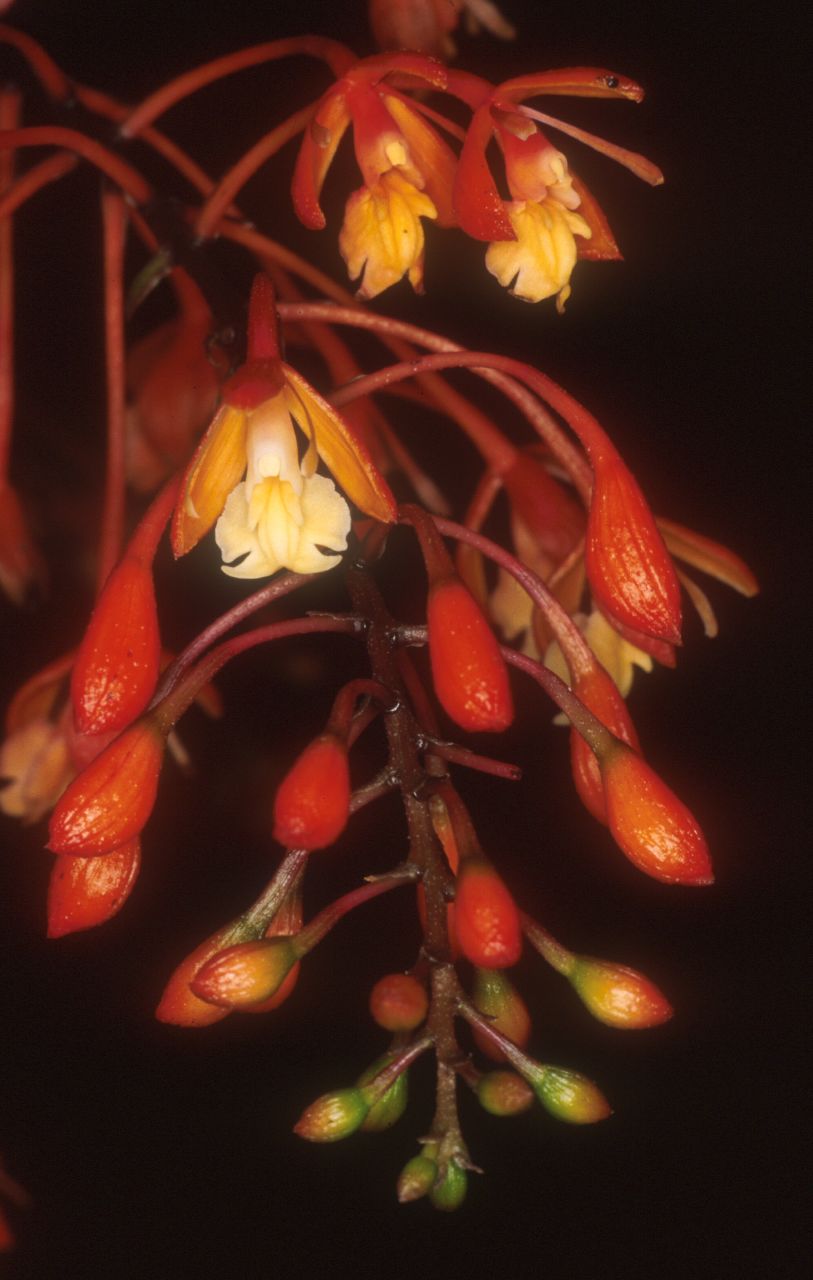

Epidendrum spathatum Schltr. 1917 GROUP Pseudepidendrum SUBGROUP Paniculatum
Photo by © Lourens Grobler
Photo by © Eric Hunt, plant grown by Dan Newman of Hanging Gardens.
TYPE Drawing by © Jimenez, Hágsater & E.Santiago and The AMO Herbario Website

 to
to 

Common Name The Spathed Epidendrum [refers to the bracts on the inflorescence but they are not true spathes]
Found in Ecuador on rocks and roadbanks at elevations of 1600 to 3200 meters as a large sized, cool to cold growing terrestrial or lithophyte with simple, laterally compressed, decumbent stems carrying 9 to 27, all along the stem, elliptic, shortly acuminate, margin entire, articulate below into the base leaves that blooms in the summer on a terminal, paniculate, occuring only once, 4 to 12.4" [10 to 31 cm] long, laterally compressed, many flowered inflorescence enveloped by 2 to 4, tubular, conduplicate, ancipitose, acuminate bracts and shorter than the ovary, triangular-lanceolate, longly acuminate floral bracts and carrying 50 to 140 simultaneously opening, resupinate flowers.
"Epidendrum spathatum belongs to GROUP Pseudepidendrum SUBGROUP Paniculatum which is characterized by the caespitose habit, unbranched stems, apical, branched inflorescence, no true spathaceous bract, and the flowers with long, thin column, a 3-lobed lip with the midlobe generally bifid and divaricate, and the filiform petals. The species is distinguished by the orange flowers with a yellow orange lip, the segments cucullate, the calli are long, and acute, the disc of the lip with 3 pad-like keels reaching the apex of the lip. There is a close resemblance to E. porphyreum but that species has larger flowers that are purple with a white splash in the lip. The two species are sympatric throughout most of their range. The natural hybrid is described in this same volume as Epidendrum x spathiporphyreum Hágsater & Dodson and is distinguished by the red colored flowers, the column and lip reddish pink, sepals dorsally verrucose, the lateral lobes of the lip dolabriform, the mid-lobe bifid, the lobes divaricate, acute, and the calli prominent, horn-like, calli and disc white turning yellow with age. Epidendrum physopus Kraenzl. has very prominent somewhat horn-like calli, but the flowers are larger, sepals .56 to .6" [14 to 15 mm] long, dorsally smooth and the lip is cordate at the base; the ovary is inflated." Hagsater etal 2010
Synonyms Epidendrum embreei Dodson 1982
References W3 Tropicos, Kew Monocot list , IPNI ; Icones Planetarum Tropicarum plate 426 Dodson 1982 as E embreei drawing fide; Orchids Travel By Air A Pictoral Safari Mulder, Mulder-Roelfsema and Schuiteman 1990 as E embreii photo fide; Native Colombian Orchids Vol 5 COS 1994 photo fide; Icones Orchidacearum 4 plate 416 Hagsater & Salazar 2001 as E embreei see recognition; Icones Orchidacearum 4 plate 463 Hagsater & Salazar 2001 as E embreei see recognition section; Icones Orchidacearum Part 12 Plate 1293 Hagsater 2009 see recognition section; Icones Orchidacearum 13 Plate 1336 Hagsater & Santiago 2010 See recognition section; Icones Orchidacearum 13 Plate 1377 Hagsater & Dodson 2010 See Recognition section; Icones Orchidacearum 13 Plate 1385 Hagsater & Santiago 2010 See recognition section; Icones Orchidacearum 13 Plate 1388 2010 drawing fide; Orchids of Tropical America Meisel 2014 photo fide as E embrei; Orchids of the Department of Valle De Cauca Colombia Vol 2 Kolanowska, Hagsater etal. 2014 photo drawing fide/photo ok; AOS Bulletin Vol 86 # 3 2017 photo fide; Orquideas, Tesoro de Colombia Vol 2 Ortiz & Uribe 2017 drawing/photo fide;
--------------------------------------------------------------------------------------------------------------------------